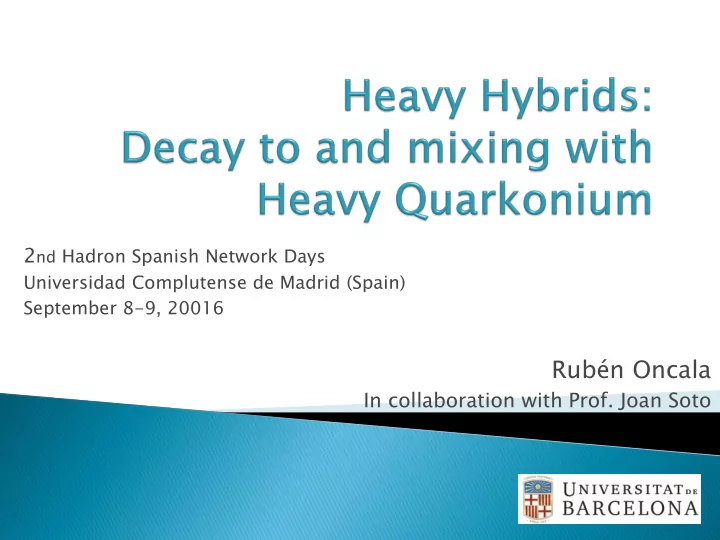

2 nd Hadron Spanish Network Days Universidad Complutense de Madrid (Spain) September 8-9, 20016 Rubén Oncala In collaboration with Prof. Joan Soto
Heavy avy Quar uarkon koniu ium is a heavy quark-antiquark pair in a colour singlet sate. Heavy avy Hybrid is a heavy quark-antiquark pair in an colour octet state and a gluon excitation that leave the system in a physical state. We study charm and bottom systems.
Understanding some of the XYZ mesons discovered in the last decades as heavy hybrids.
The effective potentials of heavy quarkonium and heavy hybrid have been calculated in the lattice: • Heavy vy quarkoni konium um • Heavy vy Hybrids • Heavy vy Tetraq raquarks uarks, , Pent ntaqua aquarks rks ... ( (adding ng light t quarks ks operators) tors) • Molecula cular r states tes • ... ...
The large ratio of the e time sc scale le for the motion of the heavy quarks and the evolution of the gluon field (which is a consequence of m Q >> ) let us to apply a non-relativistic approximation. It is possible to solve the Sch chrödin rödinger ger equati uation and get the spectrum of heavy quarkonium and heavy hybrids with the inputs: o Lattice potentials o o Heavy quarkonium spectrum (additive Energy constant) The potentials for H are obtained from fitting ing the e plot ots s of (Juge, Kuti, Morningstar (2002)), and imposing: o Weak ak coupling ng pNRQCD constraints at short distances o QCD string ng constra train ints ts at long distances
Using lattice potentials is possible to solve the Schrödinger equation and get the spectrum of heavy quarkonium and heavy hybrid: Some of the hybrid states can be identi tifi fied as XYZ mesons States with the compatibl ble e quantum number may mix. The mixing contribution could be important for states with similar energy.
The Lagrangian that describes the quarkonium and hybrid system is: Annihilate a quark Creates an antiquark We can study the mixing contributions using the Wilson loop matching between both states: Space Quarkonium Hybrid Time
Computing the Wilson loops of both operators, we can take the mixing potentials for the spin and angular momentum term: But... How can we get the Wilson loops without lattice calculations ? To take a first idea we can approximate the long and short distance and interpolate.
The short distance limit can be studied using the pNRQCD Lagrangian in the weak ak couplin ing g regime: In this Lagrangian, the hybrid state is represented as: Mixing terms in 1/m expansion. In the short distance limit the operators in the Wilson loop do not depend nd on r r, we can approximate the fields in the spin and angular momentum term as constant on the order of
The long distance behaviour of the Wilson loops is a little more complicated. We use the. QCD string. ng. A two dimensional QFT that implements ments confinement and the symmetr tries ies of the system. For the spin term, we have: And for the angular momentum term:
Using the long and short distance information, we can interpolate the effective potentials for spin and angular momentum term: Spin: Angular momentum: Using this information we can solve the mixing problem. • is the strin ing g tens nsion ion, • The long distance parameter can be extr tracted acted from available latti tice ce results of the long distance potentials. • Short rt distance constants are unknow known, no lattice data. The energy solutions depend strongly of this parameter.
To estimate the decay width of the transition from hybrids to quarkonium we use the self-energy diagram and the optical theorem:
Hybrids with L=J do not decay to Heavy Quarkonium Restr stric ictio ions: ns: Lowest heavy quarkonium: Weak coupling pNRQCD:
The lower lying states of the Heavy avy Hybrid d Spectrum ectrum have been calculated at LO in the 1/m Q expansion of the potentials. Some XYZ Z mesons sons have been ident entif ified ied as hybrids, for one of these identifications we can compute a lower bound of the decay width. Using approxima roximatio ions s for the e Wilso son loo oop match tchin ing, we can obtain the long and short distance behaviour of the mixi xing g potent tential ials. The decay cay widt dth to lower lying Heavy Quarkonium states has been estimated using weak coupling pNRQCD.
Thanks for your attention.
Recommend
More recommend